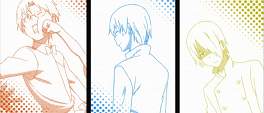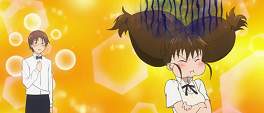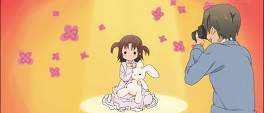The most obvious question to ask about Working!! is where it sits with regards its contemporaries. The easiest answer is: somewhere between Azumanga Daioh and Minami-ke. This puts it in an odd position where its intended audience is concerned for it's not surreal enough to garner a cult following and not accessible enough to be immediately appealing. Sure the idea of a violently androphobic girl is quirky, but the restaurant setting is littered with customs and rituals that are foreign enough to be disconnecting. The series then occupies a middle ground, rarely laugh-out-loud hilarious but frequently inspired, inventive but tends to grind its best ideas, fulfilling and satisfying but lacking the spark that would elevate this beyond a fleeting curio.
When Sota is recruited on the street by the diminutive and infectiously cheery Poplar, he is inducted into the world of the Wagnaria restaurant. Staffed by a cast of misfits which includes a layabout, parfait devouring manager, Kyouko, an overprotective sword-toting waitress, Yachiyo, the ordinarily demure but in fact freakishly strong Mahiru, and Hiroomi whose talent for leveraging information about his co-workers provides him with an easy day's work. Sota by comparison adores small and cute things but after being repeatedly punched by Mahiru, vows to cure her of her androphobia. Meanwhile all manner of shenanigans transpire in the restaurant starting with the adoption of Aoi, a wayward teenager who the head manager, Hyogo, meets on his travels to find his absent wife. And despite what the quiet Maya may claim, she is just another one of the varied and off-beat employees that make Wagnaria so eclectic.
The opening episodes restrict the narrative to events within the restaurant and though this works while Sota acclimatises to the idiosyncrasies of his colleagues, it ultimately proves too restrictive and the later episodes see various orientations of the core group go further afield. This removes some of the boundaries workplace relationships naturally have and the group stop being just staff and start bonding as friends and more, best seen with the burgeoning relationship between Mahiru and Sota. Unfortunately this also exposes how flimsy the characters are and though not quite one-trick, there is a core stable of jokes that by the end of the series begins to wear thin.
Mahiru's combative approach to men is the most prominent running gag and the one that is thoroughly run into the ground; the timid violence meted out by her at the beginning is endearing and the writers obviously caught on to the chemistry between her and Sota by deciding to make that pairing the series' focus. It runs out of steam far too quickly though and other characters like the surprisingly likeable Aoi and the spunky Poplar are marginalised. Even when the latter is afforded some development it is off the back of the main narrative and is flaccid by comparison to her earlier status when she was the driving force behind many of the series greatest and funniest moments.
To its credit there is an ongoing natural selection of jokes: weaker ones are trimmed and less frequently referenced while newer ones, usually arriving with a new character or situation, bring fresher situations. Sota's family of females is the most promising of these but it is evident there were worries of concentrating too heavily on them lest it become to much like its predecessor Minami-ke. Like that series there is a baffling fixation on the cross-dressing of boys as beautiful girls, and their relatively blasé acceptance of it, in this case Sota who was mentally primed as a toddler by being dressed in female clothes, by his parents no less. Combine this with Mahiru's borderline abusive upbringing and the show exhibits a vicious undercurrent against parents.
Episodes also rarely progress as expected, best demonstrated with the staple hot-springs episode which doesn't involve hot-springs. This can be mostly attributed to the source material's four-panel heritage which promotes segmented gags rather than extended storylines and perhaps why the Sota and Mahiru relationship is so tepid. Partly though the writing is strong enough to tiptoe around cliché, whether that is the old standard of following a pair on their date or the almost inevitable sleep over, events unfold somewhere between dramatic and slapstick, again enforcing the series resolutely middle of the road approach.
As expected, this hinders more than it helps and the lack of a hook to ensnare or a niche to fill means there is difficulty differentiating itself from the myriad other similarly positioned shows. It fits perfectly with A-1 Pictures previous series - Kannagi and Sora no Woto - both of which are enjoyable and serviceable shows but never connect in ways that braver ones do. Even the art style - pastel fresh and rife with texture - seems affable despite its consistent quality that the studio is becoming known for. In a way this exists in the shadows of greats, though it can't be described as entirely derivative it owes a debt to the series that paved the way for it.
Despite Working!!'s cheery demeanour, there is an element of sadness to it as well. Whether that's the lamentation of parents irrevocably damaging their children, a girl unable to approach the opposite gender or twelve year old willingly joining the restaurant for "experience"; the series may not attempt to tackle meaningful issues but it exposes them, however inadvertently. The series is of course at its core a comedy and at that it succeeds on more than a few occasions on raising a chuckle, the final episodes lose their way somewhat with a lackadaisical narrative that is only enjoyable insofar that the remaining characters pick up the slack. Regardless, it saves perhaps its best joke for last with Maya but joins the list of comedies that are transiently enjoyable but too swiftly forgotten.












Of course, a viewer has to quickly decide whether or not they like Inami, as their perception of her character will inevitably color all subsequent episodes, given her issues are on view VERY prominently (a directing choice apparently, to give the production a semblance of 'plot').